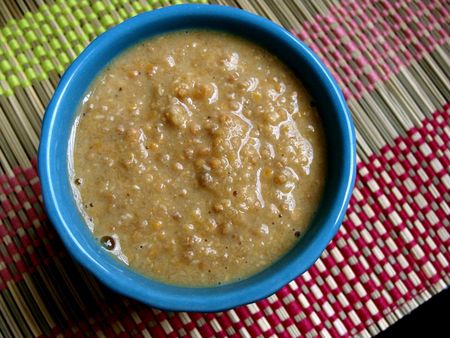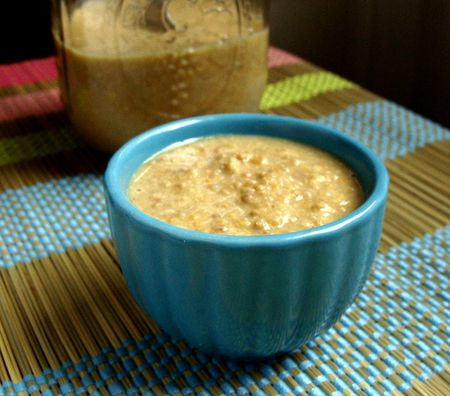homemade whole grain mustard

While shopping today, I had another one of those moments.
You know, the kind where insanity takes over and beats all reason and sense into the recesses of my mind.
I added mustard to my pantry shopping list after noticing there was just a teaspoon or two left in the jar. I've been quite happy with Maille for years. That was until today, when faced with forking over $3 for a jar, I decided to put the mustard seeds I had at home to good use.
I'd been meaning to make it ever since I came across the recipe in Heidi's new book Super Natural Every Day. By the way, this book has not left my countertop since the review proofs came in January. Now that it's officially released, you must scoop up a copy for yourself.
Well, rather than make my life easy and just buy the darn jar of Maille, as I've been doing for the last 10 years, I added homemade mustard to my "to make" list.
I can't report on the results just yet, since it takes two weeks to "cure", but that's not a worry. I figure the dining room set I'm whittling will be ready by then anyway.
New at Simple Scratch Cooking: salted molasses butter.

Homemade Whole Grain Mustard
adapted from Super Natural Every Day by Heidi Swanson (buy it here)
makes one cup
Heidi's recipe makes 2 cups, but since this was virgin terrritory (and my mustard seed turned out to be in short supply) I decided to halve it. I also didn't have champagne vinegar on hand, and thankfully my sanity returned in time to stop me from opening a bottle of real champagne to throw in a splash. Instead I let my olfactory senses lead the way and sniffed the vinegars I did have on hand, comparing the scent to that of the mustard left in the fridge, settling on a mix of white vinegar and sherry vinegar.
I also only had yellow mustard seeds, and while I miss the pretty darker hued flecks of the brown ones in my mustard, I'm confident this is going to be deliciously edible nonetheless.
One last note—my eyes have an internal auto-correct when I read the phrase "mortar and pestle" in a recipe. I used to own one, but after dusting it more than I actually used it, I finally gave it away. While I respect the subtle job a mortar and pestle deliver, it's just not an effective use of my time, so I gave the mustard seeds a whiz in the food processor to grind them.
I'd love if you all join me in this mustard-making journey. What say we all check back in two weeks and report our results?
Scant 1/3 cup (82 grams) yellow mustard seeds
1/4 cup (22 grams) mustard powder (I used Coleman's)
Scant 1/2 cup (115 ml) cold filtered water
2 tablespoons white vinegar
1 tablespoon sherry vinegar
2 tablespoons honey
3/4 teaspoons (4 grams) fine sea salt
Add the mustard seeds to a food processor and pulse until about 2/3 of the seeds are crushed.
In a small bowl, stir the mustard powder and water together with a fork. Pour in the vinegars, honey and salt, mixing well to combine. Stir in the mustard seeds. The mixture will look more like a slurry, but I trust Heidi when she says it will thicken in a few days.
Transfer to a jar, seal tightly and store in the fridge. Let the mustard "cure" for two weeks, then give it a taste and adjust the flavor with more honey, vinegar and/or salt, to your liking.

Liz the Chef
You are a mind-reader! Since my husband’s heart attack, I have made my own relish and have a recipe for ketchup to try. Now, the trio is complete! Yes, I will definitely try out your mustard. Low-sodium condiments are within my grasp! Thanks.
Mommylisa
I may have to try this after I get on my tortilla experiment!
Kristen
Love this idea! Do you know how long it will last in the fridge after it cures? Regular jars of mustard seem to last infinitely.
Barbara | VinoLuciStyle
Oh I want to do that. I love mustards; I have a whole shelf devoted to them. I can try my own blends now although the two weeks wait will kill this impatient woman. Ahh, grasshopper, patience.
Mark Scarbrough
Love this. Ever since I started making mustard on my own, I haven’t looked back. I make mine with dark beer, but I like the simplicity of your version–a much cleaner taste, I’ll bet. I’ll have to give it a try.
JP’s Note: I figured I’d start simple first to understand the process, but am very eager to branch out with other flavors, acids, etc. The Mr. would love a beer version too, I’m sure.
Peggy
Taking you up on this “challenge”! Now if you ever come across a recipe for American yellow mustard I will forever be in your debt. My husband loves it while I loathe it!
Mia
I love my homemade mustard. It’s an English Put style made with stout, so it’s got some kick. There’s nothing quite like it.
Brandi
Jenny, I have made mustard as well. It is incredibly simple to make, and I really like it with dark beer. However, sometimes it takes a long time to cure. Like months. So don’t be discouraged if the mustard is too strong after a couple of weeks. It only gets better with age.
I generally can several half-pints a year and then just put it at the back of my canning pantry. By the time I get to it, it has aged well.
Phyllis
Sunset Magazine March 2011 has some very interesting mustard recipes.
Brian @ A Thought For Food
I’m loving this wave of recipes that have come out of this cookbook! Thankfully, I have my own copy of the book… now I need to give one a try.
I know exactly what you mean about purchasing things that you know you could make yourself.
Great job with this!
Mary Sahs, ND
One of my favorites includes yellow mustard, white wine vinegar, white wine, Herbes de Provence. For my deli mustard, I use German beer, cider vinegar, mixed brown and yellow mustards, and ground caraway seeds. They’re both yummy. My instructions say you need to cure and mellow it out of the fridge… 2 weeks for hot, 4 weeks for medium, 8 weeks for mild. Once you refrigerate it, the mellowing virtually stops. Next I want to try a sweet-hot honey mustard. The possibilities are endless! 🙂
Elizabeth Baker
Okay, mine’s in the fridge. I just got back from restocking at Penzeys, so I had brown mustard seeds. Didn’t have sherry vinegar, but I had a rose wine vinegar that I figured would work. Also took a leap of faith with the honey that I used – I only had some mountain fir blossom honey that is really strong. Should be interesting.
suncatcher
do you have any thoughts on this mustard after it has aged?
JP’s Note: Yes, and I loved it even more. The first few days it’s bracingly spicy, but after a few weeks it mellows a bit. The spice is still there, it just becomes more elegant and complex instead of simply being all heat. Hope that helps!
Anjali
I made mine, afterhydrating the mustard with plain water, for 24 hrs. It had a faint aroma of rotten eggs by then. Flavoured it with honey and salt and ground it. Still smells like that and tastes really bitter. What did I do wrong?
Jennifer Perillo
My recipe doesn’t calling for hydrating the mustard a day in advance, so I’m not sure if you read the recipe incorrectly. Regardless, I don’t see why that would cause the aroma you mention. Did you do anything different to the recipe? The mustard will have a very strong, fiery scent, and the vinegar will be prominent, as well.
-JP